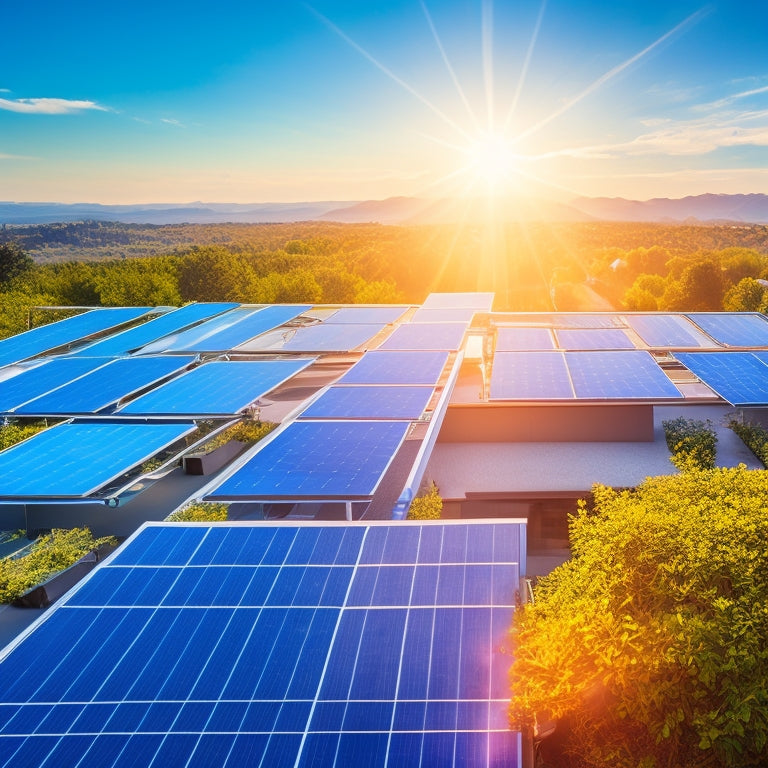
Comparing Solar Panel Brands for Best Efficiency
Share
When comparing solar panel brands for efficiency, you should examine their conversion rates and innovative technologies. Leading brands like SunPower achieve an impressive 22.8% efficiency, while LG and REC follow with around 21.7%. Unique features like bifacial solar panels can enhance output by 10-20%. Additionally, consider durability, warranty alternatives, and maintenance costs. A good warranty typically indicates product reliability, with top brands providing coverage up to 30 years. By understanding these metrics and their implications, you can make a more informed decision that suits your energy needs and investment goals. There's much more to uncover on this topic.
What You Need to Know
- SunPower leads with an average efficiency of 22.8%, making it a top choice for high performance and energy yield.
- LG Solar's NeON series and REC's Alpha series both achieve around 21.7% efficiency, combining reliability with aesthetic appeal.
- Canadian Solar, while lower at 20.5% efficiency, offers a cost-effective option for budget-conscious consumers.
- Bifacial solar panels and PERC technology significantly enhance energy output and overall efficiency, with metrics exceeding 22% for some models.
- Efficiency testing standards like IEC 61215 and IEC 61730 help consumers evaluate and compare solar panel performance reliably.
High Energy Conversion Rates
When evaluating solar panel brands, you'll want to focus on those with top-performing energy conversion rates, as this directly impacts your energy output.
Additionally, consider how optimized storage layout can help you maximize space for solar equipment.
Efficiency testing standards, such as the IEC 61215 and IEC 61730, help quantify these rates, ensuring you're investing in reliable technology.
Understanding these metrics allows you to make informed decisions customized to your energy needs.
Top Performing Brands
Which solar panel brands truly stand out with respect to energy conversion rates? When evaluating high-efficiency solar panels, several brands consistently receive accolades for their performance.
First on the list is SunPower, which boasts an impressive average efficiency of around 22.8%. This brand's reputation is reinforced by numerous positive customer reviews that highlight durability and energy yield, particularly with their Equinox System that integrates design for minimal energy loss.
Next, LG Solar follows closely, with its NeON series achieving around 21.7% efficiency. Customers often commend LG for its aesthetic design and reliability, enhancing its brand reputation in the market.
Another notable contender is Canadian Solar, which, while typically offering lower efficiency rates around 20.5%, provides excellent value for cost-conscious consumers.
You might also consider REC, with its Alpha series reaching efficiencies of 21.7%. Positive customer feedback reflects satisfaction with performance and installation processes.
Efficiency Testing Standards
Understanding the efficiency testing standards is essential for anyone looking to compare solar panel performance accurately. These standards establish the structure for measuring how well solar panels convert sunlight into usable electricity. By familiarizing yourself with efficiency metrics, including high-efficiency ratings, you'll be better equipped to evaluate different brands and their performance claims.
Common testing methodologies include the Standard Test Conditions (STC), which measures panel output under controlled conditions, and the Temperature Coefficient, which assesses performance at varying temperatures. These methodologies provide a consistent basis for comparison, allowing you to determine which solar panels yield the highest energy conversion rates.
When evaluating panels, pay attention to the reported efficiency percentages; higher values indicate better performance. Manufacturers often present various efficiency metrics, so be cautious of claims that lack transparency or subtlety.
Ultimately, understanding these efficiency testing standards enables you to make informed decisions. By focusing on data-driven comparisons, you can select solar panels that align with your energy goals and independence aspirations.
Knowing the standards helps you sift through marketing jargon and identify the true leaders in solar panel efficiency.
Cost Savings Over Time
When you evaluate solar panel brands, considering long-term savings is essential. The initial costs of installation and ongoing maintenance can greatly impact your overall financial benefits.
Additionally, understanding the importance of material durability in relation to solar panel longevity can further inform your decision. By analyzing these factors, you can determine which brand offers the best value over time.
Long-Term Savings Potential
Over the years, investing in solar panels has proven to offer significant long-term savings for homeowners. By utilizing the sun's energy, you can drastically reduce your monthly utility bills. Additionally, solar panels generate free energy, further boosting your savings and reducing grid reliance.
Many states also provide financial incentives, such as tax credits and rebates, which can lower your initial investment costs. These incentives can improve your return on investment, making solar a financially sound choice.
As energy rates continue to rise, your fixed solar energy costs shield you from inflation. This leads to substantial cumulative savings over time. For example, homeowners can save tens of thousands of dollars over the lifespan of their solar panels, which typically lasts 25 years or more.
Moreover, investing in solar panels contributes to your energy independence. You're less reliant on traditional energy sources, insulating yourself from fluctuating energy prices. This degree of control not only boosts your financial security but also supports sustainability goals.
Installation and Maintenance Costs
While long-term savings from solar energy are significant, the installation and maintenance costs also play a vital role in the overall financial equation. When considering solar panel brands, it's important to evaluate installation techniques.
Professional installation typically ranges from $1,500 to $3,000, depending on the complexity and size of your system. Skilled installers can optimize your setup, ensuring maximum efficiency and longevity.
Maintenance costs are generally low, but understanding basic maintenance tips can help you maintain your system effectively. Regularly cleaning your panels and inspecting for debris or damage can prevent performance loss.
Some manufacturers suggest a maintenance budget of about 1% of your system's total cost annually, which means keeping aside funds for occasional professional check-ups.
Ultimately, while the upfront installation cost may seem intimidating, the efficiency of your chosen solar panel brand can lead to substantial savings over time.
Factor in these expenses as you calculate your return on investment. By understanding both installation techniques and ongoing maintenance requirements, you can make an informed decision that maximizes your financial freedom while utilizing the power of solar energy.
Unique Technology Innovations
When evaluating solar panel brands, it's crucial to take into account their unique technology innovations like bifacial solar panel technology and PERC cell advancements.
Bifacial panels capture sunlight from both sides, potentially increasing energy output, while PERC cells enhance efficiency through improved light absorption.
Understanding these innovations can help you make more informed decisions based on performance and energy yield.
Bifacial Solar Panel Technology
Bifacial solar panel technology increasingly captures attention for its unique ability to harness sunlight from both sides of the panel, enhancing energy generation efficiency. This innovative approach allows you to maximize energy capture, particularly in environments with reflective surfaces, such as snow or concrete.
Bifacial advantages include increased overall energy yield, often translating to a 10-20% increase in output compared to traditional panels.
When evaluating performance metrics, it's necessary to take into account the specific conditions in which bifacial panels operate. Factors like installation angle, ground albedo, and shading can greatly influence their effectiveness.
You'll find that these panels often perform exceptionally well in wide-open spaces, allowing for ideal sunlight exposure and reflection.
Moreover, bifacial technology can lead to lower levelized cost of electricity (LCOE) over time, making them an appealing option for those seeking long-term energy independence.
With their growing popularity, it's vital to compare various brands to find the right balance of efficiency, durability, and cost. By understanding these metrics, you can make informed decisions that align with your desire for sustainable energy solutions.
PERC Cell Advancements
How do PERC (Passivated Emitter and Rear Cell) technologies enhance the performance of solar panels? PERC technology has revolutionized solar cell design by improving energy absorption and overall efficiency. By modifying the cell structure, this innovation allows for better light capture and minimizes electron recombination, leading to significant efficiency improvements.
Recent research advancements indicate that PERC cells can achieve performance metrics exceeding 22%, outperforming traditional solar cells.
The manufacturing processes for PERC cells have also evolved, making them more accessible in the market. As market trends shift toward higher efficiency and sustainability, PERC technology aligns with the growing demand for renewable energy sources.
Additionally, the environmental impact of these advancements is significant; more efficient solar panels require fewer materials and have a lower carbon footprint over their lifecycle.
Looking ahead, future developments in PERC technology promise even greater efficiency gains and cost reductions. As researchers continue to innovate, you can expect PERC cells to play a crucial role in the solar industry, enhancing your energy independence and contributing to a sustainable future.
Embracing these advancements could enable you to make informed decisions about your solar investments.
Assessing Warranty and Support
When comparing solar panel brands, warranty duration and support response times are essential factors to evaluate.
A longer warranty often indicates greater manufacturer confidence in their product, while prompt support can greatly impact your overall satisfaction.
Warranty Duration Comparison
Evaluating the warranty duration of solar panel brands is essential for making an informed investment. A strong warranty not only protects your investment but also reflects the manufacturer's confidence in their product. Most brands offer warranty options that typically range from 10 to 25 years, with some high-end manufacturers providing up to 30 years.
When comparing brands, look closely at the specifics of their warranty claims. Some may cover power output, while others encompass materials and workmanship. A longer warranty often indicates that the brand has a proven track record for durability and reliability. For example, brands like SunPower and LG are known for their extensive warranties, signaling their commitment to quality.
Also, consider the terms of the warranty. Does it include coverage for labor and installation? These details can greatly impact your long-term satisfaction and financial security.
A brand with a strong warranty and clear terms can save you from potential headaches down the road. Ultimately, understanding warranty duration and its implications will enable you to choose a solar panel brand that aligns with your freedom-seeking lifestyle and investment goals.
Support Response Times
While a strong warranty is a key aspect of your solar panel investment, the support response times from manufacturers play an essential part in your overall satisfaction. When you encounter an issue, how quickly a company responds can greatly impact your experience. Research shows that manufacturers with shorter response times tend to have higher customer satisfaction ratings.
For instance, brands like SunPower and LG often boast response times of under 24 hours, allowing you to address concerns promptly. In contrast, some lesser-known brands may take several days to respond, leaving you in limbo. This delay can affect not just your immediate concerns but also your confidence in the brand's long-term reliability.
Moreover, consider the channels of support offered. Brands that provide multiple avenues—such as phone, email, and live chat—tend to enhance customer satisfaction. You want to make certain that help is readily accessible when you need it.
Ultimately, a swift response time reflects a company's commitment to its customers, which can influence your decision-making process when selecting the best solar panel brand for your needs. Prioritize brands that not only promise quality but also deliver timely support.
Longer Lifespan Than Competitors
When evaluating solar panel brands, one critical factor is the durability and build quality of the panels.
Higher-quality materials and manufacturing processes often translate to a longer lifespan, which can greatly impact your long-term investment.
Durability and Build Quality
In the quest for reliable solar energy solutions, the durability and build quality of solar panels play an essential role in their overall performance and longevity. When selecting a solar panel, you should prioritize models that offer superior weather resistance and high material quality.
Panels designed with sturdy materials can withstand harsh environmental conditions, including hail, heavy winds, and extreme temperatures.
Research indicates that brands using tempered glass and aluminum frames tend to outperform competitors regarding resilience. For instance, panels rated for high wind loads and snow loads often last longer, reducing the likelihood of costly repairs or replacements.
Additionally, panels with better weather resistance help maintain efficiency over time, ensuring you get the most from your investment.
You should also consider warranty periods offered by different brands. A longer warranty often reflects a manufacturer's confidence in their product's durability.
Many reputable brands provide 25-year warranties, signaling their commitment to quality.
Frequently Asked Questions
What Factors Influence Solar Panel Efficiency Ratings?
Several factors influence solar panel efficiency ratings, including wattage output, conversion efficiency, temperature coefficients, and shading effects. Understanding these elements helps you choose the right panels for maximizing energy harvest and achieving greater independence.
How Do Weather Conditions Affect Solar Panel Performance?
Weather's like a conductor, orchestrating your solar panel performance. Temperature effects can enhance or hinder output, while humidity impact, shading issues, and seasonal variations play their parts, creating a harmony of efficiency you can't ignore.
Can I Install Different Brands of Solar Panels Together?
Yes, you can install different brands of solar panels together, but verify they're compatible. Mixed brand performance may vary, so check specifications and inverter compatibility to optimize efficiency and overall system effectiveness for your energy needs.
What Is the Ideal Angle for Solar Panel Installation?
Installing solar panels at a tilt angle of 30 to 45 degrees can enhance energy production by up to 25%. Optimizing solar panel orientation guarantees you capture maximum sunlight, improving efficiency and providing greater energy freedom.
How Do I Maintain My Solar Panels for Optimal Efficiency?
To maintain your solar panels for peak efficiency, regularly clean them using safe techniques and verify your inverter's performance. Keeping both in top shape maximizes energy production and guarantees your investment pays off effectively.
Explore More
When it comes to selecting solar panels, efficiency isn't just a number; it's the lifeblood of your investment. By assessing energy conversion rates and innovative technologies against warranty support and lifespan, you're charting the solar terrain with the precision of a seasoned pilot. Remember, the best choice isn't merely about upfront costs but long-term savings and reliability. So, choose wisely, and let your solar expedition illuminate both your home and your wallet for years to come.
Related Posts
-

Solar Power for Reducing Carbon Footprint
Solar power is an effective strategy for reducing your carbon footprint. By adopting solar energy, you can cut greenh...
-

Affordable Sustainable Building Materials for Homes
You can build an eco-friendly home on a budget by choosing affordable sustainable materials. Consider using reclaimed...
-

Green Energy Alternatives for Independent Living
To enhance your independent living, consider green energy alternatives like solar panels and wind turbines. These opt...


